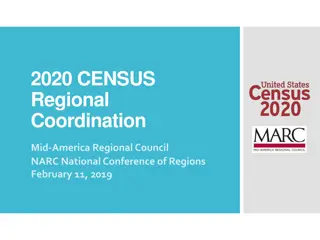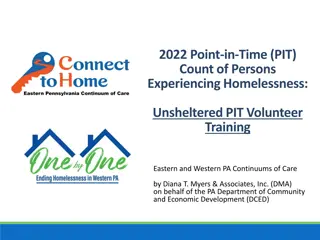Strategies for Reaching Hard-to-Count Communities Using Low-Response Score
Explore how to leverage a low-response score to engage with hard-to-count communities effectively. Learn about ROAM mapping tool, the 2020 Census goal, and the significance of Low Response Score (LRS) in identifying areas for targeted outreach. Discover hard-to-count variables and how to utilize data to improve self-response rates.
Download Presentation

Please find below an Image/Link to download the presentation.
The content on the website is provided AS IS for your information and personal use only. It may not be sold, licensed, or shared on other websites without obtaining consent from the author. Download presentation by click this link. If you encounter any issues during the download, it is possible that the publisher has removed the file from their server.
E N D
Presentation Transcript
How to Use a Low-Response Score to Reach Hard-to-Count Communities Macy D. Hurwitz Partnership Specialist United States Census Bureau Field Division, Denver Region, Austin 1
Session Outline What is our goal? Purpose of ROAM Introduction to the low response score Background on the Planning Database What is a Census Tract? Live Demo of ROAM You ve identified a hard-to-count community. Now what? Resources Questions 2
What is the goal of the 2020 Census? To count everyone once, only once, and in the right place. 3
What is our goal for this session? When you leave here today, you should have an idea of how to use the ROAM mapping tool to identify hard-to-count areas, analyze what makes them hard to count, and plan appropriate outreach for 2020. 4
ROAM (Response Outreach Area Mapper) ROAM is a web mapping application developed to make hard-to- count areas easier to identify. It provides a socioeconomic and demographic characteristic profile of these areas. Used to determine location and understanding those areas characteristics so the Census Bureau can tailor communications and partnership campaigns. Helps management plan for field resources. For example, how many staff to hire and what language skills should those staff have. Informs decision-making efforts to help improve self-response rates. 5
Introduction to the Low Response Score (LRS) LRS is a model-driven metric calculated in-house. Calculated at the census tract and block group level. Represents the predicted mail non-response rate to be interpreted as the percentage of households predicted to not self-respond to the Decennial Census. A high LRS indicates a predicted low self-response rate harder-to- survey area. LRS is stored in the Census Bureau s Planning Database (PDB). 6
Hard-to-count variables described in ROAM 0-5 years old 18-24 years old Below poverty line Renters Foreign born No Internet access Don t speak English well 7
Background on the Planning Database (PDB) Contains the LRS, a subset of American Community Survey 5-year estimates, and 2010 Census operational data The LRS allows you to target hard-to-survey areas. The ACS estimates and 2010 Census data allow you to view the socioeconomic and demographic characteristics of the area to determine why it might be hard to count. Available in two formats: Comma delimited file (www.census.gov/research/data/planning_database). Census API (www.census.gov/developers). ROAM is a mapping gateway into part of the PDB. 8
What is a Census tract? Small, relatively permanent statistical subdivisions of a county or equivalent entity. Generally have a population size between 1,200 and 8,000; the optimum size considered ~4,000 people. Generally follow visible and identifiable features but may also follow nonvisible legal boundaries. Boundaries are delineated with the intention of being maintained over a long time for statistical comparison between censuses. Occasionally split due to population growth or merged as a result of substantial population decline in an area. Updated by local participants (tribal, state, and local governments) prior to each Decennial Census as a part of the Participant Statistical Areas Program (PSAP). 9
ROAM Application (www.census.gov/roam) Accessible to anyone through a web browser (no download required). Hosted by the Census Bureau. Provides a map and data table interface for users to identify and learn about hard-to-count census tracts. 11
Youve identified a hard-to-count community. Now what? Look carefully at the data. Some areas have multiple factors that make them hard to count. Try to get a complete picture of the challenges present in that area. Think about who knows that area well. Who are the trusted voices? Who could you enjoin to help you reach this part of the community? Create a strategy that engages trusted voices who will help you reach this hard-to-count area. Develop a specific, but flexible plan. Talk to a Partnership Specialist if you need additional info. The Partnership Team is here as a resource for you. 12
Resources To access the application and for additional information, please visit www.census.gov/roam User Guide, Data Dictionary, Frequently Asked Questions, Quick Tips Guide, and Fact Sheet. Planning Database: www.census.gov/research/data/planning_database Questions about the Low Response Score or Planning Database can be directed to: Census.PDB.questions@census.gov. 13
Questions? 14























